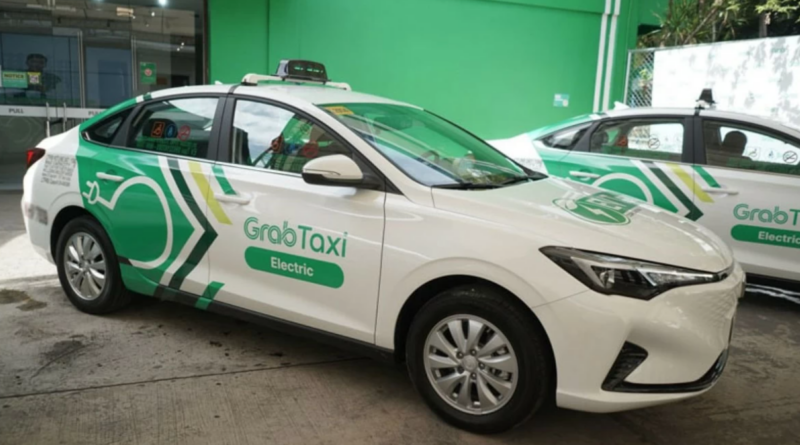Ride-hailing giant Grab is taking significant strides in sustainable urban transport by integrating electric vehicles (EVs) into its taxi fleet in the Philippines and Singapore. Earlier last month, Grab launched its fully electric taxi service, “GrabTaxi Electric,” in collaboration with EV Taxi Corp. This marks the Philippines’ first fully electric, on-demand taxi fleet, approved by the country’s Land Transportation Franchising and Regulatory Board (LTFRB). Meanwhile, Singapore will welcome an all-electric fleet this July, further enriching the green options available on the Grab app.
Currently, Grab’s EV taxis are undergoing testing in the Philippines and are accessible only to select users in key cities within Metro Manila, including Makati, Taguig, Pasig, Mandaluyong, Paranaque, and Pasay. The initial fleet features the Chang’an Eado EV460. This rollout follows a successful pilot study conducted in June 2024 with BYD Philippines, which evaluated the operational and financial viability of EVs for drivers and fleet operators. This initiative is part of a broader regional partnership between Grab and BYD, aiming to provide up to 50,000 BYD EVs for Grab’s driver-partners across Southeast Asia.
Expanding Green Mobility Across the Region
Beyond Metro Manila, Grab plans to extend its electric taxi and GrabCar EV services to other regional cities, such as Davao and Cagayan de Oro. This initiative aligns with national efforts to promote EV adoption, supporting the Electric Vehicle Industry Development Act (EVIDA) and the Department of Energy’s push for sustainable transport solutions. The ultimate goal is to foster “green livelihoods” for drivers while offering cleaner, quieter rides for commuters.
The taxis are primarily operating near airports, with a limited number currently deployed. “This is not just about offering another ride option,” Grab Philippines Country Head Ronald Roda stated. He emphasized that Grab PH’s broader eco-mobility strategy includes expanding EV adoption across its GrabCar fleet in regional cities like Davao and Cagayan De Oro within the year. “It’s about fundamentally changing the DNA of urban transport in the Philippines — one that aligns with our sustainability commitments, empowers Filipino commuters, and creates meaningful green livelihoods. Sustainability cannot be a distant ideal; it must be something you can book, ride, and feel today,” Roda added.
Collaborative Efforts and Future Prospects
GrabTaxi Electric will be implemented in a phased rollout, supported by in-app sustainability features such as voluntary contributions for environmental conservation efforts with every Grab transaction. There will also be deeper collaboration with government and private sector partners to accelerate EV ecosystem readiness nationwide. “As a local operator, we’re proud to be at the forefront of this transformation,” said EV Taxi Corp President Frankie Ang. “Our partnership with Grab proves that when multinational platforms and local innovators work together, we can fast-track a cleaner, more inclusive future for transport — one that delivers value for both passengers and drivers alike.”
Grab is also intensifying its commitment to EV adoption in Singapore with the introduction of “GrabCab” in July 2025. The existing Grab Taxi fleet in Singapore, which uses a variety of internal combustion engine (ICE) taxis, will integrate hybrid and electric vehicles. GrabCab initially debuted with 40 fifth-generation Toyota Prius (hybrid) vehicles. The company plans to progressively incorporate more low- and zero-emission models, such as the Hyundai Kona hybrid, starting in August 2025, with the ultimate goal of transitioning to a fully electric fleet within the year.
Innovating Urban Transport in Singapore
Having received its street-hail service operator license in April 2025, GrabCab is now Singapore’s sixth taxi operator. The company has a three-year grace period to expand its fleet to meet a minimum size requirement of 800 taxis. GrabCab’s model integrates traditional street-hail services with Grab’s digital platform, enabling drivers to switch seamlessly between street-hail and app-based bookings. This hybrid approach aims to bridge accessibility gaps for commuters while enhancing operational efficiency through technology.
GrabCab offers various benefits for drivers, including medical leave, instant fare payouts, safe driving bonuses, and discounts on fuel and EV charging across four providers islandwide. Vehicles are equipped with integrated mobile data terminals and AI-powered tools (KartaDongle and KartaDashcam) to bolster safety, efficiency, and real-time road condition data collection. GrabCab fares adhere to existing taxi industry rates, including applicable surcharges and booking fees.
Grab’s strategy with GrabCab is to “grow the pie” by attracting new and inactive taxi drivers, thereby increasing the overall supply of available taxis in Singapore. This move represents a substantial step towards decarbonizing the city-state’s public transport, with the potential to set a precedent for other urban centers in the region.
As Grab continues to pioneer sustainable transport solutions, the company’s efforts in Manila and Singapore could serve as a model for other cities looking to balance economic growth with environmental responsibility. With ongoing collaborations and technological advancements, Grab is poised to play a pivotal role in shaping the future of urban mobility in Southeast Asia.
About The Author
 Microsoft Announces 9,000 Job Cuts Amid AI Investment Surge
Microsoft Announces 9,000 Job Cuts Amid AI Investment Surge Tesla’s Q2 2025 Deliveries Fall Short Amidst Growing Competition from GM
Tesla’s Q2 2025 Deliveries Fall Short Amidst Growing Competition from GM US Judge Orders Huawei to Face Racketeering and Fraud Charges
US Judge Orders Huawei to Face Racketeering and Fraud Charges Bay Area Residents Among Hundreds Charged in $14.6 Billion Health Fraud Crackdown
Bay Area Residents Among Hundreds Charged in $14.6 Billion Health Fraud Crackdown Lean Hog Futures Rise Amid Market Fluctuations
Lean Hog Futures Rise Amid Market Fluctuations